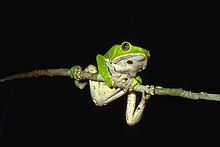Kambo cleanse
| Kambo cleanse | |
|---|---|
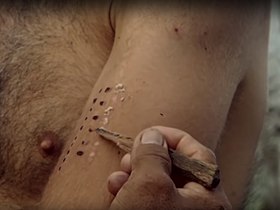 A kambo ceremony: the frog secretion is being applied to the burnt skin | |
| Alternative therapy | |
| Claims | It is claimed that kambo will help with a number of issues including, depression, anxiety, addiction, fertility, fever, mental clarity, negative energy and the cleansing of the body |
| Benefits | Placebo |
| This article is part of a series on |
| Alternative medicine |
|---|
 |
A Kambo cleansing, also known as a Kambo circle or Kambo ceremony, Kambo, vacina-do-sapo, or sapo (from Portuguese "sapo," lit. meaning "toad"), is a purge using skin secretions of the kambô, a species of frog. The effects on humans usually include nausea, vomiting, and diarrhea; use of kambo has caused several deaths. Kambo, which originated as a folk medicine practice among the Amazon indigenous peoples, is also administered as an alternative medicine treatment in the West, often as a pseudoscientific cleanse or detox. The ceremony involves burning an arm or leg and applying the kambo secretion directly to the burn. Promoters claim that kambo helps with several illnesses or injuries. There is no scientific evidence that it is an effective treatment.
Common terms[]
- Kampo pae, name used by the Noke Kuin (formerly Katukina)[1]
- Dow kiet, a word used by the Matses[2]
- Sapo, kampô, kampu, vacina de sapo or vacina da floresta, in Brazilian Portuguese[3]
"Kambô" is a common name of Phyllomedusa bicolor, an Amazonian tree frog, also known as the blue-and-yellow frog, bicolored tree-frog, giant monkey frog, giant leaf frog, or waxy-monkey tree frog. "Sapo" means "frog" in Portuguese (and "toad" in Spanish).[4] The frog is an anuran amphibian that inhabits the Amazon and Orinoco basins in South America.[5]
History[]
Natives who practice kambo are Panoan-speaking indigenous groups in the southeast Amazon rainforest, such as the Mayoruna, Matses, Marubo, Amahuaca, Kashinawa, Katukina, Yawanawá, and the Kaxinawá.[6][7][8] There are ethnographic studies on the use of kambo in traditional Noke Kuin medicine in the region of the state of Acre, in the Brazilian Amazon.[9]
Since the mid-20th-century, kambo has also been practiced in urban regions of Brazil.[10][7] In 2004, Brazil banned the sale and marketing of kambo.[11] Import is illegal in Chile.[12] Outside of South America, it first became known as an alternative therapy in the late 2010s.[13]
Indigenous use[]

To collect the secretions from the frog's body, first, the amphibian has to be caught. A practitioner will tie the frog to four sticks placed in the ground with his limbs completely stretched. The pulling causes the frog to become stressed enough to activate its defense mechanism and secrete a substance containing peptides from its skin.[14] After obtaining secretions, the frog goes back into the wild. The secretions are then left to dry.[14] Small burns are created on the skin, and a small dose of the frog secretions applied to the open wounds.[14] In native practice, the secretions are removed from the wounds after 10 to 15 minutes, ending the acute symptoms.[8]
Traditional practitioners claim that it aids fertility, cleanses the body and soul, increases strength, and brings good luck to hunts.[10][15] It's used by natives to expel "panema" (bad spirit) and to induce abortions.[8] The secretions are also commonly used in people who suffer from tikish or laziness: a condition perceived as unfavorable by the Noke Kuin as the person stops participating socially.[16]
Joaquim Luz, a Yamanawa leader, criticized commercial sales and kambo's use without the preparation or permission of indigenous peoples, saying that the toxin users are at risk of death.[11] Other native groups have also expressed concerns.[17][18]
Non-indigenous use[]
Outside South America, a kambo ceremony can involve just two people, the practitioner, the participant, or many participants at once, which is known as a kambo circle. Participants are encouraged to bring plenty of water, a towel, and a bucket.[13] There are usually yoga mats on the floor and the ceremony room, which is often the practitioner's living room, is heavily incensed.[13]
During the ceremony, the participant's skin is deliberately burnt multiple times, usually on the upper arm or leg, by the practitioner using a smoldering stick or vine.[14] The practitioner uses saliva or water to reconstitute the frog secretions and place it on top of the burnt skin.[14] Participants may be encouraged to shout "Viva" whenever one of them vomits into their bucket.[19] Short-term effects include violent nausea, vomiting, diarrhea, edema (swelling) of the face, headaches, and tachycardia. The secretions seem to be vasoactive (affecting the circulation), explaining why they are absorbed rapidly.[8]
Medical claims[]
Non-indigenous users and practitioners of kambo claim that the alternative medicine helps with a wide variety of issues and conditions. These claims include treating addiction, depression, and chronic pain,[13][19][20] reducing fevers,[13] increasing fertility,[13] boosting energy and physical strength,[15][19] and improving mental clarity.[19] It is also claimed that kambo removes negative energy[13] and cleanses the soul and body.[15]
There is currently no scientific basis to these claims. There is no solid medical evidence on how the frog toxins work, whether they are useful for treating anything, and whether they can be used safely: no clinical trials have tested them on humans, as of November 2019.[8] Reports of adverse events are numerous, including for use with experienced guidance.[8]
Kym Jenkins of the Royal Australian and New Zealand College of Psychiatrists, in a Sydney Morning Herald article, said "people with mental illness are a more vulnerable group anyway for a variety of reasons. If you're feeling very anxious or very depressed ... you're automatically more vulnerable and you could be more susceptible to people advertising or marketing a quick fix. I do have concerns that people can be preyed upon when they are more vulnerable."[21] Kambo has been described by a toxicologist as a risky, potentially life-threatening procedure.[13]
Marketing[]
In non-indigenous use, the frog secretion is described and marketed as a "detox" treatment, cleanse,[14] purge,[13] and as a "vaccine," which is "good for everything."[22] Kambo has been marketed both as a "scientific" remedy, emphasizing the biochemistry, and as a "spiritual" remedy, emphasizing its indigenous origins.[7] Purging (deliberate vomiting) has been a popular treatment since the 1800s.[14] "Detox" has been described by Edzard Ernst, emeritus professor of complementary medicine, as a term for conventional medical treatments for addiction, which has been "hijacked by entrepreneurs, quacks, and charlatans to sell a bogus treatment."[23]
In Brazil, given the growth in the consumption of kambo in urban centers, there has been criticism by indigenous people, academics and communicators regarding the cultural appropriation of indigenous knowledge, the process of extracting the secretion of the Phyllomedusa bicolor frog, the form of transmission of wisdom, and the price charged by the ritual and the mystification of the origin of the frog.[18]
There is also concern about pharmacological patents on the peptides identified in kambo (see biopiracy), the commercialization of the kambo outside its place of origin, and the unknown impact on frog populations, since many more are now removed from their natural habitats.[22]
Environmental impact[]
The increased use of kambô rituals reduced the population of Phyllomedusa bicolor in their natural habitats: the forests of Bolivia, Peru, Brazil, the Guianas, Colombia, and Venezuela.[24][25][10] Phyllomedusa bicolor is not considered an endangered species by the IUCN .[26] Besides Phyllomedusa (species?), other threatened endemic frog species of South America's neotropical regions have been poached and smuggled on the black market.[24] Forensic wildlife investigations have concluded that the ingredients found in these frog species result in lethal outcomes.[24][clarification needed]
- Species used[citation needed]

Phyllomedusa bicolor
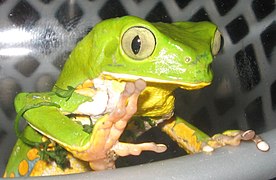
Tree frog, Caetité, Bahia, Brazil

Phyllomedusa hypochondrialis
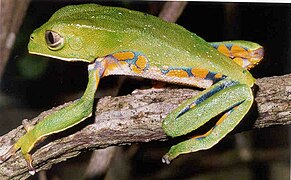
Phyllomedusa burmeisteri

Phyllomedusa theringii

Phyllomedusa trinitatis

Phyllomedusa distincta
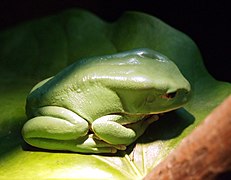
Bolivian Phyllomedusa

Phyllomedusa azurea
Parasitology[]
Smuggling amphibians such as Phyllomedusa bicolor can spread parasites.[citation needed] zoos keep frogs for conservation purposes, and there are many parasites present in these animals that naturally occur only in the native habitats. It's recommended for imported amphibians to go through a quarantine process to verify they are not spreading parasites that could damage other ecosystems.[28] Parasites found in these frogs are (51.12%) differing from a (12.88%) present in lizard species.[clarification needed] Individuals who want to have them as pets are obligated and encouraged to get them examinatined to detect gastrointestinal parasites that could potentially be harmful.[29] Neocosmocercella fisherae is the first nematode species found parasitising Phyllomedusa bicolor from the Brazilian Amazon Region.[30]
Notable deaths[]
A 40-year-old businessman was charged in Brazil in 2008 with the illegal exercise of medicine and felony murder after administering kambo toxins to a business colleague, who died; the deceased's son, who said his father had pressured him into participating, suffered more minor effects.[31][10] In Chile in 2009, Daniel Lara Aguilar, who suffered from chronic lumbar disc disease, died immediately after taking kambo administered by a local shaman in a mass healing ceremony; the autopsy was inconclusive due to preexisting conditions.[11][32] The medical literature reported the 2018 case in Italy of a person with no known preexisting conditions besides obesity, who, according to autopsy reports, died of cardiac arrhythmia while under the effects of kambo use.[33][10] In March 2019, kambo practitioner Natasha Lechner suffered a cardiac arrest and died while receiving kambo.[13][34] In April 2019, a homicide investigation was opened into the death by "severe cerebral edema" of a young person who had taken kambo toxins in Chile; the import of the frog and its secretions is illegal in Chile.[35][36]
Pharmacology[]

The frog secretes a range of small chemical compounds of a type called peptides, which have several different effects.[38] Peptides found in the frog secretions include dermorphin and endorphins. The peptides then bind to opioid receptors, sauvagine, a vasodilator, and dermaseptin, which exhibits antimicrobial properties in vitro.[8] Various other substances such as phyllomedusin, phyllokinin, caerulein, and adrenoregulin are also present.[38] There is active medical research into the peptides found in the skin secretions of Phyllomedusa bicolor, focusing on discovering their biological effects. There have been some preclinical trials in mice and rats, but no phase-1 tests or clinical trials of safety in humans, as of November 2019.[8]
See also[]
References[]
- ^ Lima (2000): 160.
- ^ Erspamer et al (1993): 1100.
- ^ Lima (2008): 170.
- ^ den Brave, Paul S; Bruins, Eugéne; Bronkhorst, Maarten W G A (2014). "Phyllomedusa bicolor skin secretion and the Kambô ritual". Journal of Venomous Animals and Toxins Including Tropical Diseases. 20 (1): 40. doi:10.1186/1678-9199-20-40. ISSN 1678-9199. PMC 4582952. PMID 26413084.
- ^ "Phyllomedusa bicolor". AmphibiaWeb: Information on amphibian biology and conservation. [web application]. Berkeley, California: AmphibiaWeb. 2015. Retrieved 15 April 2016.
- ^ Daly, J. W.; Caceres, J.; Moni, R. W.; Gusovsky, F.; Moos, M.; Seamon, K. B.; Milton, K.; Myers, C. W. (1992). "Frog secretions and hunting magic in the upper Amazon: identification of a peptide that interacts with an adenosine receptor". Proceedings of the National Academy of Sciences. 89 (22): 10960–10963. Bibcode:1992PNAS...8910960D. doi:10.1073/pnas.89.22.10960. ISSN 0027-8424. PMC 50462. PMID 1438301.
- ^ Jump up to: a b c Lima, Edilene Coffaci de; Labate, Beatriz Caiuby (15 October 2007). ""Remédio da Ciência" e "Remédio da Alma": os usos da secreção do kambô (Phyllomedusa bicolor) nas cidades". Campos - Revista de Antropologia Social. 8 (1). doi:10.5380/cam.v8i1.9553.
- ^ Jump up to: a b c d e f g h Bartels, Emiel Jacob Henri; Dekker, Douwe; Amiche, Mohamed (26 November 2019). "Dermaseptins, Multifunctional Antimicrobial Peptides: A Review of Their Pharmacology, Effectivity, Mechanism of Action, and Possible Future Directions". Frontiers in Pharmacology. 10: 1421. doi:10.3389/fphar.2019.01421. PMC 6901996. PMID 31849670.
robust data on pharmacokinetics, efficacy and safety in humans are currently lacking
(please note that this is not a very reliable medical source; see talk tab) - ^ Lima, Edilene Coffaci de Lima (25 November 2014). "Cobras, xamãs e caçadores entre os Katukina (pano)". Tellus (in Portuguese). 8 (15): 35–57. doi:10.20435/tellus.v0i15.161. ISSN 2359-1943. Retrieved 21 May 2019.
- ^ Jump up to: a b c d e f Silva, Francisco Vaniclei Araújo da; Monteiro, Wuelton Marcelo; Bernarde, Paulo Sérgio (2019). ""Kambô" frog (Phyllomedusa bicolor): use in folk medicine and potential health risks". Revista da Sociedade Brasileira de Medicina Tropical. 52: e20180467. doi:10.1590/0037-8682-0467-2018. ISSN 1678-9849. PMID 30942261.
- ^ Jump up to: a b c Mundo, Leire Ventas (27 April 2016). "Kambó, el polémico veneno que se usa en Sudamérica como medicina para curarlo todo". BBC News Mundo (in Spanish).
- ^ Vallejos, Ricardo Pérez. "San Felipe: joven mujer murió tras un ritual de sanación con veneno de rana". La Nación (in Spanish).
- ^ Jump up to: a b c d e f g h i j Scherer, Jennifer (7 November 2019). "Australians Are Using This Amazonian Frog Poison Aa A Controversial Alternative Medicine". SBS. Archived from the original on 7 November 2019. Retrieved 15 December 2019.
- ^ Jump up to: a b c d e f g Mariana, Jasmine, Lauren, Van Zeller, Brown, Effron (29 March 2017). "This Amazonian tree frog's poison has become part of the latest supercleanse trend". ABC News. Archived from the original on 29 March 2017. Retrieved 15 December 2019.CS1 maint: multiple names: authors list (link)
- ^ Jump up to: a b c Schwarcz, Joe (29 September 2019). "The Right Chemistry: No evidence-based science supports kambo ritual". The Montreal Gazette. Archived from the original on 2 October 2019. Retrieved 16 December 2019.
- ^ Lima (2000): 75-76.
- ^ Silva, Francisco Vaniclei Araújo da; Monteiro, Wuelton Marcelo; Bernarde, Paulo Sérgio (2019). ""Kambô" frog (Phyllomedusa bicolor): use in folk medicine and potential health risks". Revista da Sociedade Brasileira de Medicina Tropical. 52: e20180467. doi:10.1590/0037-8682-0467-2018. PMID 30942261.
- ^ Jump up to: a b Labate y Lima (2007): 74.
- ^ Jump up to: a b c d Lavoipierre, Angela (7 September 2018). "Tree frog poison being used as an alternative medicine". ABC News. Archived from the original on 7 September 2018. Retrieved 15 December 2019.
- ^ Duncan, Elly (22 November 2019). "South Australian Pair Banned Indefinitely From Providing Frog Poison Health Treatment 'Kambo'". SBS. Archived from the original on 22 November 2019. Retrieved 16 December 2019.
- ^ Hall, Bianca (17 May 2019). "Pedlars of new age cures are 'preying' on mentally ill, doctors warn". The Sydney Morning Herald. Archived from the original on 17 May 2019. Retrieved 16 December 2019.
- ^ Jump up to: a b Bernarde, Paulo Sérgio; Santos, Rosimeyri Aparecida (20 June 2011). "Utilização medicinal da secreção ("vacina-do-sapo") do anfíbio kambô (Phyllomedusa bicolor) (Anura: Hylidae) por população não-indígena em Espigão do Oeste, Rondônia, Brasil". Biotemas. 22 (3). doi:10.5007/2175-7925.2009v22n3p213.
- ^ Mohammadi, Dara (5 December 2014). "You can't detox your body. It's a myth. So how do you get healthy?". The Observer.
- ^ Jump up to: a b c Byard, Roger W. (2016-06-01). "Traditional medicines and species extinction: another side to forensic wildlife investigation". Forensic Science, Medicine, and Pathology. 12 (2): 125–127. doi:10.1007/s12024-016-9742-8. ISSN 1556-2891. PMID 26798031.
- ^ Silva, Francisco Vaniclei Araújo da; Monteiro, Wuelton Marcelo; Bernarde, Paulo Sérgio; Silva, Francisco Vaniclei Araújo da; Monteiro, Wuelton Marcelo; Bernarde, Paulo Sérgio (27 November 2007). ""Kambô" frog (Phyllomedusa bicolor): use in folk medicine and potential health risks". Revista da Sociedade Brasileira de Medicina Tropical. 52: e20180467. doi:10.1590/0037-8682-0467-2018. ISSN 0037-8682. PMID 30942261.
- ^ Azevedo-Ramos, Claudia; Marca, Enrique La (2008-10-30). "IUCN Red List of Threatened Species: Phyllomedusa bicolor". IUCN Red List of Threatened Species. Retrieved 2020-09-26.
- ^ Paves, Heiti (2015-04-30), English: Caenorhabditis elegans, a free-living, transparent nematode (roundworm), retrieved 2020-11-26
- ^ Hamann, Mónika Inés; Kehr, Arturo Ignacio; Gonzalez, Cynthya Elizabeth (December 2012). "Community Structure of Helminth Parasites of Leptodactylus bufonius (Anura: Leptodactylidae) from Northeastern Argentina". Zoological Studies. ISSN 1021-5506.
- ^ Hallinger, Malek J.; Taubert, Anja; Hermosilla, Carlos (2020-09-22). "Endoparasites infecting exotic captive amphibian pet and zoo animals (Anura, Caudata) in Germany". Parasitology Research. 119 (11): 3659–3673. doi:10.1007/s00436-020-06876-0. ISSN 1432-1955. PMC 7578172. PMID 32960371.
- ^ Dos Santos, Ana Nunes; de Oliveira Rodrigues, Allan Rodrigo; Dos Santos Rocha, Fábio José; Dos Santos, Jeannie Nascimento; González, Cynthya Elizabeth; de Vasconcelos Melo, Francisco Tiago (11 December 2017). "Neocosmocercella fisherae n. sp. (Nematoda: Cosmocercidae), a parasite of the large intestine of Phyllomedusa bicolor (Boddaert) (Anura: Phyllomedusidae) from the Brazilian Amazon". Systematic Parasitology. 95 (2–3): 293–300. doi:10.1007/s11230-017-9770-0. ISSN 1573-5192. PMID 29230677. S2CID 3516919.
- ^ Menocchi, Simone (25 April 2008). "Investigada morte de homem que tomou 'vacina do sapo' - Geral". Estadão (in Portuguese).
- ^ "Buscan a "chamanes" por muerte de paciente que recibió veneno de rana". BioBioChile - La Red de Prensa Más Grande de Chile (in Spanish). 22 December 2009.
- ^ Aquila, I; Gratteri, S; Sacco, MA; Fineschi, V; Magi, S; Castaldo, P; Viscomi, G; Amoroso, S; Ricci, P (May 2018). "The Biological Effects of Kambo: Is There a Relationship Between its Administration and Sudden Death?". Journal of Forensic Sciences. 63 (3): 965–968. doi:10.1111/1556-4029.13641. PMID 28886207. S2CID 10408804.
- ^ MacKenzie, Bruce (21 March 2019). "Frog poison investigated as possible cause of woman's death following kambo ceremony". ABC News. Archived from the original on 21 March 2019. Retrieved 16 December 2019.
- ^ Vallejos, Ricardo Pérez. "San Felipe: joven mujer murió tras un ritual de sanación con veneno de rana". La Nación (in Spanish).
- ^ Ries, Secretaría. "Chile: una joven muere tras un tratamiento ritual con el veneno de la rana kambó". InfoCatólica (in Spanish).
- ^ User:Calvero (2006-04-23), English: Chemical structure of DermorphinEspañol: Dermorfina, retrieved 2020-11-26
- ^ Jump up to: a b Kwen-Jen Chang; Frank Porreca; James Woods (11 December 2003). "Chapter 11: Deltorphins". The Delta Receptor. CRC Press. p. 176. ISBN 978-0-8247-5858-5.
Further reading[]
- den Brave, Paul S; Bruins, Eugéne; Bronkhorst, Maarten W G A (2014). "Phyllomedusa bicolor skin secretion and the Kambô ritual". Journal of Venomous Animals and Toxins Including Tropical Diseases. 20 (1): 40. doi:10.1186/1678-9199-20-40. ISSN 1678-9199. PMC 4582952. PMID 26413084.
- Byard, Roger W. (2019). "Is voluntary envenomation from the kambô ritual therapeutic or toxic?". Forensic Science, Medicine and Pathology. 16 (2): 205–206. doi:10.1007/s12024-019-00192-5. ISSN 1547-769X. PMID 31630322.
- Pseudoscience
- Alternative detoxification
- Fringe science
- Scientific skepticism
- Alternative medicine
- South American traditional medicine
- Amphibians and humans
- Amphibian diseases
